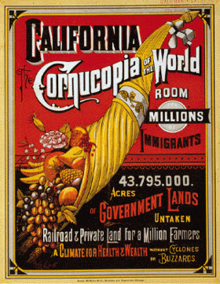Mythological symbol of abundance, also called the horn of plenty From Wikipedia, the free encyclopedia
In classical antiquity, the cornucopia (/ˌkɔːrn(j)əˈkoʊpiə, -n(j)uː-/; from Latin cornu 'horn' and copia 'abundance'), also called the horn of plenty, was a symbol of abundance and nourishment, commonly a large horn-shaped container overflowing with produce, flowers, or nuts. In Greek, it was called the "horn of Amalthea" (Ancient Greek: κέρας Ἀμαλθείας, romanized: kéras Amaltheías),[1] after Amalthea, a nurse of Zeus, who is often part of stories of the horn's origin.

Baskets or panniers of this form were traditionally used in western Asia and Europe to hold and carry newly harvested food products. The horn-shaped basket would be worn on the back or slung around the torso, leaving the harvester's hands free for picking.


Mythology offers multiple explanations of the origin of the cornucopia. One of the best-known involves the birth and nurturance of the infant Zeus, who had to be hidden from his devouring father Cronus. In a cave on Mount Ida on the island of Crete, baby Zeus was cared for and protected by a number of divine attendants, including the goat Amalthea ("Nourishing Goddess"), who fed him with her milk. The suckling future king of the gods had unusual abilities and strength, and in playing with his nursemaid accidentally broke off one of her horns, which then had the divine power to provide unending nourishment, as the foster mother had to the god.[2]
In another myth, the cornucopia was created when Heracles (Roman Hercules) wrestled with the river god Achelous and ripped off one of his horns; river gods were sometimes depicted as horned.[3] This version is represented in the Achelous and Hercules mural painting by the American Regionalist artist Thomas Hart Benton.
The cornucopia became the attribute of several Greek and Roman deities, particularly those associated with the harvest, prosperity, or spiritual abundance, such as personifications of Earth (Gaia or Terra); the child Plutus, god of riches and son of the grain goddess Demeter; the nymph Maia; and Fortuna, the goddess of luck, who had the power to grant prosperity. In Roman Imperial cult, abstract Roman deities who fostered peace (pax Romana) and prosperity were also depicted with a cornucopia, including Abundantia, "Abundance" personified, and Annona, goddess of the grain supply to the city of Rome. Hades, the classical ruler of the underworld in the mystery religions, was a giver of agricultural, mineral and spiritual wealth, and in art often holds a cornucopia.[4]
In modern depictions, the cornucopia is typically a hollow, horn-shaped wicker basket filled with various kinds of festive fruit and vegetables. In most of North America, the cornucopia has come to be associated with Thanksgiving and the harvest. Cornucopia is also the name of the annual November Food and Wine celebration in Whistler, British Columbia, Canada. Two cornucopias are seen in the flag and state seal of Idaho. The Great Seal of North Carolina depicts Liberty standing and Plenty holding a cornucopia. The coats of arms of Colombia, Panama, Peru, Venezuela, Victoria, Australia and Kharkiv, Ukraine, also feature the cornucopia, symbolizing prosperity.
Cornucopia motifs appear in some modern literature, such as Terry Pratchett's Wintersmith, and Suzanne Collins's The Hunger Games.
The horn of plenty is used for body art and at Thanksgiving, as it is a symbol of fertility, fortune and abundance.[5][failed verification]
Seamless Wikipedia browsing. On steroids.